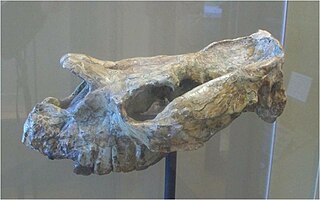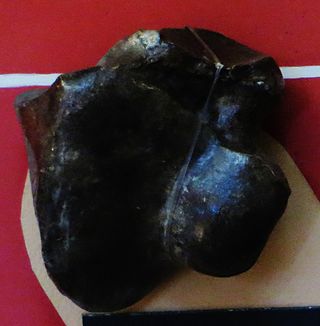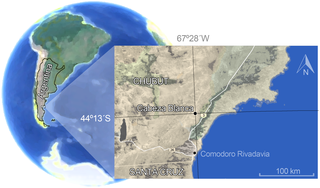
Peltephilus, the horned armadillo, is an extinct genus of armadillo xenarthran mammals that first inhabited Argentina during the Oligocene epoch, and became extinct in the Miocene epoch. Notably, the scutes on its head were so developed that they formed horns. Aside from the horned gophers of North America, it is the only known fossorial horned mammal. P. ferox had skull about 11.7 centimetres (4.6 in), and estimated body mass is around 11.07 kilograms (24.4 lb).

Pyrotherium is an extinct genus of South American ungulate, of the order Pyrotheria, that lived in what is now Argentina and Bolivia, during the Late Oligocene. It was named Pyrotherium because the first specimens were excavated from an ancient volcanic ash deposit. Fossils of the genus have been found in the Deseado and Sarmiento Formations of Argentina and the Salla Formation of Bolivia.

Rhynchippus is an extinct genus of notoungulate mammals from the Late Oligocene of South America. The genus was first described by Florentino Ameghino in 1897 and the type species is R. equinus, with lectotype MACN A 52–31. Fossils of Rhynchippus have been found in the Agua de la Piedra and Sarmiento Formations of Argentina, the Salla and Petaca Formations of Bolivia, the Tremembé Formation of Brazil, and the Moquegua Formation of Peru.

Cramauchenia is an extinct genus of litoptern South American ungulate. Cramauchenia was named by Florentino Ameghino. The name has no literal translation. Instead, it is an anagram of the name of a related genus Macrauchenia. This genus was initially discovered in the Sarmiento Formation in the Chubut Province, in Argentina, and later it was found in the Chichinales Formation in the Río Negro Province and the Cerro Bandera Formation in Neuquén, also in Argentina, in sediments assigned to the SALMA Colhuehuapian, as well as the Agua de la Piedra Formation in Mendoza, in sediments dated to the Deseadan. In 1981 Soria made C. insolita a junior synonym of C. normalis. A specimen of C. normalis was described in 2010 from Cabeza Blanca in the Sarmiento Formation, in sediments assigned to the Deseadan SALMA.

Leontiniidae is an extinct family comprising eighteen genera of notoungulate mammals known from the Middle Eocene (Mustersan) to Late Miocene (Huayquerian) of South America.
The Deseadan age is a period of geologic time within the Oligocene epoch of the Paleogene to the Early Miocene epoch of the Neogene, used more specifically within the SALMA classification of South America. It follows the Tinguirirican and precedes the Colhuehuapian age.

Octodontotherium is an extinct genus of ground sloth of the family Mylodontidae, endemic to South America during the Late Oligocene (Deseadan). It lived from 29 to 23 Mya, existing for approximately 6 million years.

The Malargüe Group is a group of geologic formations of the Neuquén Basin of the Mendoza, Neuquén, Río Negro and La Pampa Provinces in northern Patagonia, Argentina. The formations of the Malargüe Group range in age between the middle Campanian to Deseadan, an Oligocene age of the SALMA classification, straddling the Cretaceous–Paleogene boundary, about 79 million to 30 million years in age. The group overlies the older Neuquén Group, separated by an unconformity dated to 79 Ma. The rocks of the Malargüe Group comprise both marine and continental deposits which are over 400 m (1312 ft) thick in total.

Pharsophorus is an extinct genus of borhyaenoid sparassodont that inhabited South America during the Middle to Late Oligocene epoch.

Archaeohyrax is a genus of extinct notoungulate mammal known from the Middle Eocene to Oligocene of Argentina and Bolivia.

Prohegetotherium is an extinct genus of hegetotheriid notoungulates from the Late Oligocene to Early Miocene of the Agua de la Piedra, Mariño & Sarmiento Formations of Argentina, the Petaca and Salla Formations of Bolivia, and Fray Bentos Formation of Uruguay.
The Agua de la Piedra Formation is a Late Oligocene geologic formation of the Malargüe Group that crops out in the southernmost Precordillera and northernmost Neuquén Basin in southern Mendoza Province, Argentina.
Ronwolffia is an extinct genus of horned armadillo (Peltephilidae), distantly related to the modern species of armadillos and to the extinct glyptodonts. It lived during the Oligocene in what is now the Salla Formation in Bolivia.
Proadinotherium is an extinct genus of toxodontid. It lived between the Late Oligocene and the Early Miocene in what is now South America.

The Sarmiento Formation, in older literature described as the Casamayor Formation, is a geological formation in Chubut Province, Argentina, in central Patagonia, which spans around 30 million years from the mid-Eocene to the early Miocene. It predominantly consists of pyroclastic deposits, which were deposited in a semi-arid environment. It is divided up into a number of members. The diverse fauna of the Sarmiento Formation, including a variety of birds, crocodilians, turtles and snakes, also includes many mammals such as South American native ungulates as well as armadillos, and caviomorph rodents.
Pternoconius is an extinct genus of macraucheniid litoptern from the Late Oligocene and Early Miocene of Argentina. Fossils of this genus have been found in the Sarmiento Formation of Argentina.
Incamys is an extinct genus of chinchillid rodent that lived during the Late Oligocene (Deseadan) in what is now South America. Fossils of this genus have been found in the Salla Formation of Bolivia and the Agua de la Piedra and Sarmiento Formations of Argentina. Research on endocasts suggest they were group living using call communication like modern chinchillas.

Proborhyaena is an extinct genus of proborhyaenid sparassodont that lived during the Oligocene of what is now South America. It is considered to be the largest of the sparassodonts.
Moqueguahippus is an extinct genus of notohippid notoungulates that lived during the Late Oligocene of what is now Peru. Fossils of this genus have been found in the Moquegua Formation of Peru, which it was named after.
Progaleopithecus is an extinct genus of interatheriid notoungulate that lived during the Late Oligocene of Argentina. Fossils of this genus have been found in the Agua de la Piedra, Deseado, and Sarmiento Formations of Argentina.




















